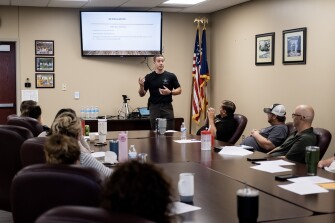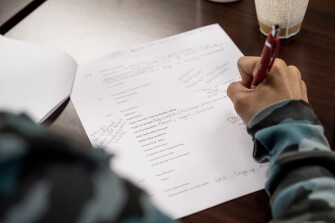Teachers With Guns: District by District, a Push to Arm Educators Is Growing
Seconds matter during a school shooting. A rural superintendent wondered, what if staff members could intervene before police arrived?
An act of mass violence hasn’t yet touched the Benjamin Logan Local School District.
Superintendent John Scheu is thankful for that.
But for years, every time news broke about yet another school shooting, Scheu faced a handful of “what if?” questions.
What if a school in this small, rural district about an hour northwest of Columbus, Ohio—where the closest police outpost is 10 miles away—was the next target of a shooting? What if Benjamin Logan students were the next to have to huddle in closets sending “I love you” texts to friends and family? What if Scheu’s community was the next to have to mourn the loss of beloved students and staff members?
“If it can happen in all of these other places, it could happen here,” he said.
So, Scheu and his district invested hundreds of thousands of dollars in security. They hired school resource officers who are stationed at each of the district’s three schools. Security cameras send live feeds to the local sheriff’s office. Staff are reminded often that exterior doors are not to be propped open or left unlocked for any reason.
There’s a new mental health clinic at one of the schools, staffed with counselors trained to help the district’s roughly 1,600 students and 225 staff members.
But what if the threat came from someone already inside?
Students and teachers have lockdown drills, and, as has become commonplace in American schools, they know to pull down the shades and lock the classroom doors before hiding quietly from a threat. But, beyond that, there isn’t much they would be able to do but “wait and hope that help would come,” Scheu said.
Except, Scheu asked himself, what if there were staff members trained to intervene? What if a handful of teachers, aides, and others could quickly reach for a firearm if an active shooter were targeting students?
“When you’re talking about putting out an active shooter threat, it’s a matter of seconds, not a matter of minutes,” said Scheu, who has served as superintendent in the district since July 2020. “And it’s a matter of life and death.”
After a year of planning, the district’s first “Armed Response Team” was in place to start the 2023-24 school year, part of a growing trend in Ohio and elsewhere in which schools tap teachers and other employees to act as the first line of armed defense against an active shooter.
An evolution of thinking on arming teachers
Scheu isn’t the first to have the idea of allowing trained educators to be armed, but he brings unique experience to the process of standing up a team of teachers with access to firearms on campus.
In fact, Benjamin Logan is the second district to develop a program under Scheu’s oversight in which teachers and other school staff take firearms training and have weapons at the ready.
He ushered in a related program at a nearby district nearly a decade ago, in Ohio’s Sidney City Schools, when he served as superintendent there.

In 2013—just a few months after 26 people were killed at Sandy Hook Elementary School in Connecticut—the district approved an armed response team, which remains in place today. Staff members in the program keep their firearms and bulletproof vests in specialized safes in the buildings that only open with the team members’ fingerprints, Scheu said. Nobody, however, carries a concealed firearm with them on campus.
Sidney City Schools’ current superintendent did not respond to EdWeek interview requests over the summer.
There are no national data on just how many schools have armed staff, but the controversial change has gained steam in the past decade, corresponding with a rise in American school shootings and widespread attention to the issue of gun violence on campuses.
Thirty-three states now allow teachers to carry guns at school, if approved by their local district. Those state laws have all passed in the past decade, after South Dakota became the first state to enact legislation allowing educators to be armed in March 2013.
Is 24 hours enough training?
The 17 staff members who started the school year on Sept. 5 as part of Benjamin Logan’s inaugural Armed Response Team spent the summer preparing. The group is a mix of 10 men and seven women, a combination of teachers and other school employees.
After undergoing background checks and mental health screenings, they participated in a three-day, 24-hour training at the end of June, which included classroom-based lessons and practice handling and using firearms at a local shooting range.
The lessons addressed when and when not to engage with a shooter, first aid, firearms handling, and self-defense, and included simulated drills of active shooter situations and target practice.

Under the Ohio state law allowing districts to have armed staff members, the participants required approval from the local sheriff’s office, the firing range instructor, coursework instructors, and Scheu.
Armed Response Team members will also have to complete eight hours of additional training each year, and the experts who conduct the training will have to reapprove the participants.
Ohio’s main teachers’ union and its primary police union both opposed the change. In a year of debate, legislators heard testimony from those opposed to the change more than 360 times, compared with 20 times from those in support, according to NPR.
Jim Irvine, president of pro-gun Ohio’s Buckeye Firearms Foundation recently told a local news outlet that he doesn’t think the teachers across the state who have been certified to carry guns on campus in the past year, since the reduction in required training hours took effect, have been adequately trained.
“There are some things that are a mess with trainers that have been approved by the state that really don’t have the experience and the knowledge, we don’t think, to be doing this,” Irvine told TV station WSYX.
Scott DiMauro, the president of the Ohio Education Association—the state teachers’ union that represents educators across the state—agreed that the teachers involved are not receiving sufficient training. Twenty-four hours is not enough, he said, pointing out that other states, like Florida, require more than 100 hours.
“If we’re going to go this route, they should at least set a higher standard,” DiMauro said.

